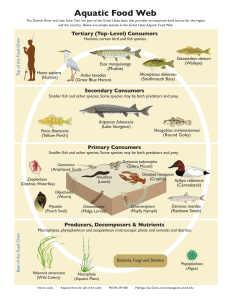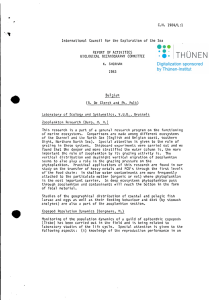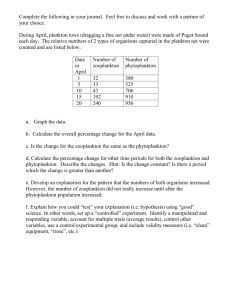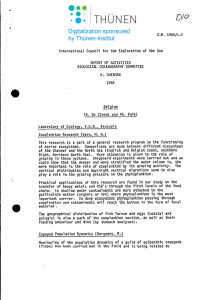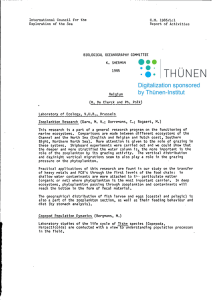Research Journal of Applied Sciences, Engineering and Technology 6(2): 339-344,... ISSN: 2040-7459; e-ISSN: 2040-7467
advertisement
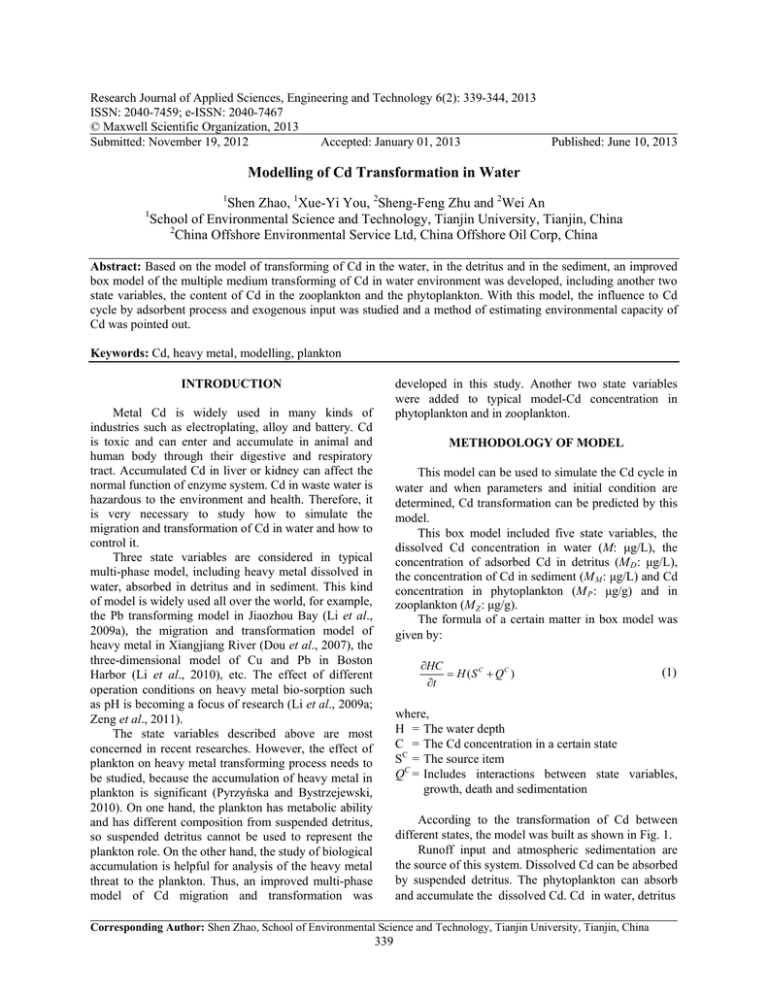
Research Journal of Applied Sciences, Engineering and Technology 6(2): 339-344, 2013 ISSN: 2040-7459; e-ISSN: 2040-7467 © Maxwell Scientific Organization, 2013 Submitted: November 19, 2012 Accepted: January 01, 2013 Published: June 10, 2013 Modelling of Cd Transformation in Water 1 Shen Zhao, 1Xue-Yi You, 2Sheng-Feng Zhu and 2Wei An School of Environmental Science and Technology, Tianjin University, Tianjin, China 2 China Offshore Environmental Service Ltd, China Offshore Oil Corp, China 1 Abstract: Based on the model of transforming of Cd in the water, in the detritus and in the sediment, an improved box model of the multiple medium transforming of Cd in water environment was developed, including another two state variables, the content of Cd in the zooplankton and the phytoplankton. With this model, the influence to Cd cycle by adsorbent process and exogenous input was studied and a method of estimating environmental capacity of Cd was pointed out. Keywords: Cd, heavy metal, modelling, plankton developed in this study. Another two state variables were added to typical model-Cd concentration in phytoplankton and in zooplankton. INTRODUCTION Metal Cd is widely used in many kinds of industries such as electroplating, alloy and battery. Cd is toxic and can enter and accumulate in animal and human body through their digestive and respiratory tract. Accumulated Cd in liver or kidney can affect the normal function of enzyme system. Cd in waste water is hazardous to the environment and health. Therefore, it is very necessary to study how to simulate the migration and transformation of Cd in water and how to control it. Three state variables are considered in typical multi-phase model, including heavy metal dissolved in water, absorbed in detritus and in sediment. This kind of model is widely used all over the world, for example, the Pb transforming model in Jiaozhou Bay (Li et al., 2009a), the migration and transformation model of heavy metal in Xiangjiang River (Dou et al., 2007), the three-dimensional model of Cu and Pb in Boston Harbor (Li et al., 2010), etc. The effect of different operation conditions on heavy metal bio-sorption such as pH is becoming a focus of research (Li et al., 2009a; Zeng et al., 2011). The state variables described above are most concerned in recent researches. However, the effect of plankton on heavy metal transforming process needs to be studied, because the accumulation of heavy metal in plankton is significant (Pyrzyńska and Bystrzejewski, 2010). On one hand, the plankton has metabolic ability and has different composition from suspended detritus, so suspended detritus cannot be used to represent the plankton role. On the other hand, the study of biological accumulation is helpful for analysis of the heavy metal threat to the plankton. Thus, an improved multi-phase model of Cd migration and transformation was METHODOLOGY OF MODEL This model can be used to simulate the Cd cycle in water and when parameters and initial condition are determined, Cd transformation can be predicted by this model. This box model included five state variables, the dissolved Cd concentration in water (M: μg/L), the concentration of adsorbed Cd in detritus (M D : μg/L), the concentration of Cd in sediment (M M : μg/L) and Cd concentration in phytoplankton (M P : μg/g) and in zooplankton (M Z : μg/g). The formula of a certain matter in box model was given by: ∂HC = H (S C + QC ) ∂t (1) where, H = The water depth C = The Cd concentration in a certain state SC = The source item QC = Includes interactions between state variables, growth, death and sedimentation According to the transformation of Cd between different states, the model was built as shown in Fig. 1. Runoff input and atmospheric sedimentation are the source of this system. Dissolved Cd can be absorbed by suspended detritus. The phytoplankton can absorb and accumulate the dissolved Cd. Cd in water, detritus Corresponding Author: Shen Zhao, School of Environmental Science and Technology, Tianjin University, Tianjin, China 339 Res. J. Appl. Sci. Eng. Technol., 6(2): 339-344, 2013 sediment can return to water in certain condition of water flow and the formula was given by Li et al. (2010): QMM = −k2 ( f1 M M − M ) + w0 M D Kw0 − MM H H (3) where, w 0 = The rate of sedimentation (1/d) K = The factor of re-suspension Cd adsorbed in detritus: The interaction item of Cd adsorbed in detritus was given by Li et al. (2010): Fig. 1: Cd cycle in water wM Kw0 − 0 D+ QMD = MM H H +k1 (θ f 0 M D − M ) + µ ZM M Z CZ + µ PM M P and phytoplankton can be predated by zooplankton and accumulating in its body. The dead body of zooplankton and phytoplankton return to water in form of suspended particles. Cd in detritus can enter into sediment and then return to water in certain condition (Dong et al., 2010). In polluted area, the heavy metal in sediment has a high level of concentration and can be desorbed sometimes, so Cd can return to water from sediment. Strictly speaking, Cd in detritus can also be desorbed, but this process can be ignored, because the desorption scale is relatively small (Blackmore, 2001). where, : The contribution to the Cd μ ZM M Z C Z & μ PM M P in detritus, from death process of zooplankton and phytoplankton respectively μ ZM : The death rate of zooplankton C Z : The content of zooplankton in water μ PM : The death rate of phytoplankton Cd concentration in zooplankton: Cd concentration in zooplankton is the mass of Cd per unit mass of phytoplankton in μg/g. Cd in zooplankton is mainly from dissolved Cd and its food, including phytoplankton and detritus. According to the principle of bio-accumulation and bio-magnification, Cd will accumulate in zooplankton’s body. In case of death and breeding, Cd in zooplankton can return to water in form of detritus. Its interactive formula was given by Pan and Wang (2008): Formulas in model: In formula (1), the interaction item QC varies from state variables and formula for each variable will be discussed in this section. Dissolved Cd: Under the hypothesis that the concentration Cd in detritus is uniformed in the spatial distribution, considering the mass transfer process in the liquid-solid interface on detritus, the adsorption of dissolved Cd (Huang et al., 2008) and the release of Cd from sediment, the change of dissolved Cd concentration was given by Li et al. (2009b): = Q M -k1 (θ f 0 M D − M ) + k2 ( f1 M M − M ) where, M : Dissolved Cd (μg/L) k 1 : Adsorption coefficient between dissolved particulate Cd (1/d) θ : The content of suspended particles in volume water (μg/L) f 0 : The distribution coefficient between water particles M D : The concentration of Cd in particles (μg/L) k 2 : The desorption coefficient between water sediment (1/d) (4) Q M Z = ku M + AE ( IR × − ( ke + g ) M Z (2) MD θ + IP × M P ) (5) where, k u : The uptake rate constant from dissolved Cd AE : The Cd assimilation efficiency of zooplankton IR : The ingestion rate of zooplankton IP : The ingestion rate of phytoplankton k e : The Cd efflux rate constant g : Growth rate constant of zooplankton M D /θ: The concentration of Cd in detritus, which can be taken by zooplankton and unit and Cd concentration in phytoplankton: Cd concentration in phytoplankton (M P : μg/g) was given like zooplankton: and Cd in sediment: Sedimentation of Cd in detritus contributes a lot to Cd in sediment (M M : μg/L). Cd in P Q M= kup M − AE × IP × M P − g P M P 340 (6) Res. J. Appl. Sci. Eng. Technol., 6(2): 339-344, 2013 Table 1: Initial condition Variables Dissolved Cd Cd adsorbed in particles Cd in sediment Cd concentration in phytoplankton Cd concentration in zooplankton Value 0.037 1 0.190 0.120 1.400 Units μg/L μg/L μg/L μg/g μg/g Table 2: Parameters in model Symbol Value Definition k1 3.630×10-3 d-1 Adsorption coefficient between dissolved and particulate Cd θ 2.430×103 Content of suspended particles in unit μg/L volume water ƒ0 20 Distribution coefficient between water and particles k2 5.200×10-4 d-1 Desorption coefficient between water and sediment ƒ1 4.000 Distribution coefficient between water and sediment K 0.200 Factor of re-suspension ku 0.455 L/ (g·d) Uptake rate constant from dissolved Cd of zooplankton AE 0.876 Cd assimilation efficiency of zooplankton IR 0.400 g/ (g·d) Ingestion rate of zooplankton ke 0.090 d-1 Cd efflux rate constant of zooplankton g 0.195 d-1 Growth rate constant of zooplankton IP 0.400 g/ (g·d) Ingestion rate of phytoplankton k up 2.280 L/ (g·d) Uptake rate constant from dissolved Cd of phytoplankton gP 0.471 d-1 Growth rate constant of phytoplankton where, k up = The uptake rate constant from dissolved Cd of phytoplankton g P = The growth rate constant of phytoplankton Implement of the model: The initial concentration of state variables was given in Table 1 and parameters in this study were determined according to relative papers (Pan and Wang, 2008; Reinfelder et al., 1998), as shown in Table 2. The exogenous input was mainly composed of runoff input and atmospheric sedimentation and the input amount in this model were 3.33×10-3 mg/m3·d and 6.67×10-3 mg/m3·d, respectively. The classical Runge-Kutta method was adopted to solve the model. After verification of time step independence, the time step was fixed for 1 h. Fig. 2: Cd concentration of different states in water in 720 h (30 days) metabolism. The Cd in zooplankton keeps increasing at first because of bio-accumulation and then drops down. The influence of adsorption process: Through a series of experiments of different adsorption coefficient values, the influence of adsorption process to the Cd cycle was analyzed. The adsorption coefficient values from 2.71 to 9.07×10-3 d-1 and 3.60×10-3 d-1 was adopted in the example according to the value measured in laboratory (Dong et al., 2010). Three adsorption coefficient values were adopted in experiments, which were 2.88×10-3 d-1, 3.60×10-3 d-1 and 4.32×10-3 d-1. The result was shown in Fig. 3. Dissolved Cd is strongly influenced by the adsorption coefficient. Higher adsorption coefficient RESULTS AND DISCUSSION Example: The water depth was 10 m and water stayed still. Computing time was 720 h (30 days). And the result was shown in Fig. 2. As shown in Fig. 2, dissolved Cd concentration tends to be stable and Cd in detritus keeps growing, because dissolved Cd can be absorbed by suspended detritus. Most suspended particles fall to sediment, so Cd is accumulated in sediment. The Cd concentration of phytoplankton keeps decreasing because of 341 Res. J. Appl. Sci. Eng. Technol., 6(2): 339-344, 2013 Cd in detritus (μg/L) Dissolved Cd (μg/L) 0.04 0.02 3.60×10-3 d-1 2.88×10-3 d-1 4.32×10-3 d-1 5 4 3 2 3.60×10-3 d-1 2.88×10-3 d-1 4.32×10-3 d-1 1 0 0 0 240 480 0 720 240 3 Cd in zooplakton (μg/g) Cd in sediment (μg/L) 3.5 2.5 2 1.5 1 3.60×10-3 d-1 2.88×10-3 d-1 4.32×10-3 d-1 0.5 0 240 480 1.8 1.6 1.4 1.2 1 0.8 0.6 0.4 0.2 0 3.60×10-3 d-1 2.88×10-3 d-1 4.32×10-3 d-1 0 720 240 480 720 Time (h) Time (h) Cd in zooplakton (μg/g) 720 T ime (h) T ime (h) 0 480 2 1.5 1 3.60×10-3 d-1 2.88×10-3 d-1 4.32×10-3 d-1 0.5 0 0 240 480 720 T ime (h) Fig. 3: Influence of adsorption coefficient value brings stronger absorption reaction and lower dissolved Cd concentration. On the contrary, lower adsorption coefficient value brings higher dissolved Cd concentration. Adsorption process is significant to dissolved Cd in water. This process has a weak influence on Cd concentration in detritus and sediment, but it has a strong influence on Cd content in phytoplankton and zooplankton. Because Cd ion can be uptaked by phytoplankton and zooplankton, the Cd content in phytoplankton and zooplankton will be higher when dissolved Cd concentration is higher. When the sources are increased by 50%, every state variable is increased distinctly. Cd in phytoplankton keeps increasing instead of decreasing. The tendency of the other state variables is basically the same as in the example. This implies zooplankton is more sensitive to exogenous input. When water is in a certain degree of Cd pollution, Cd in zooplankton body will be gradually accumulated and is hard to be metabolic. When the sources are increased by 100%, Cd ion concentration keeps increasing at first and tends to be stable at last. It suggests that adsorbing dissolved Cd is more difficult in this situation. When the sources are increased by 200%, dissolved Cd is increasing significantly and Cd concentration of phytoplankton is reduced at first and then goes up and tendsto be stable at last. It indicates that as a primary productivity, phytoplankton has strong metabolic ability and low The influence of exogenous input: In order to study the influence of exogenous input, the two exogenous sources are increased by 50, 100 and 200%, respectively and the result of simulation is shown in Fig. 4. 342 Res. J. Appl. Sci. Eng. Technol., 6(2): 339-344, 2013 6 Cd in detritus (μg/L) 0.04 0.02 example increase 50% increase 100% 0 0 240 480 Time (h) Cd ion concentration (μg/L) 0.04 0.02 0 example increase 50% increase 100% increase 200% 2 0 720 0.06 example increase 100% 4 0 increase 50% increase 200% 240 480 720 T ime (h) Cd in zooplankton (μg/g) Dissovled Cd (μg/L) 0.06 2.5 2 1.5 1 0.5 example increase 100% increase 50% increase 200% 0 0 240 480 720 0 240 480 720 T ime (h) T ime (h) Cd in detritus (μg/L) 6 4 example increase 50% increase 100% increase 200% 2 0 0 240 480 720 T ime (h) Fig. 4: Influence of exogenous input sensitive degree of exogenous input and can suffer strong exogenous input. On the other hand, the increase of every state variable implies that Cd pollution is beyond the environmental capacity completely and the water cannot recover through self-purification without water treatment. Environmental capacity can be estimated by adapting the exogenous input and observing the tendency of state variables in a series of results. in the zooplankton and the phytoplankton. And classical Rage-Kutta method was adopted to solve this model. As was shown in the results, some conclusions can be drawn as follow. Adsorption process was significant to Cd cycle in water, especially to Cd dissolved in water. Higher adsorption coefficient value brings stronger absorption reaction and lower dissolved Cd concentration. Another conclusion can be drawn that Cd content of phytoplankton and zooplankton is positive correlative to exogenous input, by comparing among different exogenous input conditions. When exogenous resources are increased by 200%, Cd pollution is beyond environmental capacity and Cd concentration keeps increasing in the whole water environment and plankton. Environmental capacity could be estimated by adapting resources and observing the results. CONCLUSION Based on the traditional model of transforming of Cd in water, in detritus and in sediment, an improved box model of Cd cycle in water was developed, including another two state variables-the content of Cd 343 Res. J. Appl. Sci. Eng. Technol., 6(2): 339-344, 2013 Li, G.X., P.Y. Xue, Q.Z. Li, Y.J. Gao and C.Z. Yan, 2009b. Effect of pH on cadmium bio-sorption by Myriophyllum spicatum. Res. Environ. Sci., 22(11): 1329-1333. Li, L., F. Pala, M. Jiang, C. Krahforst and G.T. Wallace, 2010. Three-dimensional modeling of Cu and Pb distributions in Boston Harbor, Massachusetts and Cape Cod bays. Estuarine Coastal Shelf Sci., 88(4): 450-463. Pan, K. and W.X. Wang, 2008. Validation of biokinetic model of metals in the scallop Chlamys nobilis in complex field environments. Environ. Sci. Technol., 42(16): 6285-6290. Pyrzyńska, K. and M. Bystrzejewski, 2010. Comparative study of heavy metal ions sorption onto activated carbon: Carbon nanotubes and carbon-encapsulated magnetic nanoparticles. Colloids Surf. A, 362(1): 102-109. Reinfelder, J.R., N.S. Fisher, S.N. Luoma, J.W. Nichols and W.X. Wang, 1998. Trace element trophic transfer in aquatic organisms: A critique of the kinetic model approach. Sci. Total Environ., 219(2): 117-135. Zeng, F., S. Ali, H. Zhang, Y. Ouyang, B. Qiu, F. Wu and G. Zhang, 2011. The influence of pH and organic matter content in paddy soil on heavy metal availability and their uptake by rice plants. Environ. Pollut., 159(1): 84-91. ACKNOWLEDGMENT The authors wish to thank the project of marine promotion by science and technology of Tianjin (KJXH2011-15) and support of China Offshore Oil Corporation. REFERENCES Blackmore, G., 2001. Interspecific variation in heavy metal body concentrations in Hong Kong marine invertebrates. Environ. Pollut., 114(3): 303-311. Dong, X., C. Li, J. Li, J. Wang, S. Liu and B. Ye, 2010. A novel approach for soil contamination assessment from heavy metal pollution: A linkage between discharge and adsorption. J. Hazard. Mater., 175(1): 1022-1030. Dou, M., J. Ma, D.Y. Xie and X. Li, 2007. Numerical simulation on cadmium pollution emergency in north river [J]. J. Zhengzhou Univ., Eng. Sci., 2(3): 29-38. Huang, B.S., X.P. Li, Z. Fan and X.H. Wang, 2008. The transferring and transforming model of heavy metals with water-suspended substance-mud in rivers. China Safety Sci. J., 18: 23-28. Li, J.L., K.Q. Li and X.L. Wang, 2009a. Study on model of transport and transformation of lead (II) in multimedia environment of Jiaozhou Bay. Marine Environ. Sci., 28: 516-521. 344
